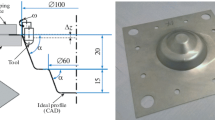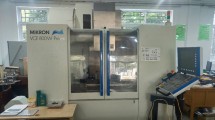Abstract
The panel production of small batch sizes for the hull of large ships requires a stable and flexible forming process, which is momentarily manually controlled by a system operator. The manual forming press control includes the metal sheet handling above the forming tool for defining the contact point and engagement depth of the sword and subjective monitoring of the forming degree by using the light gap check method. For objectifying the process monitoring and reducing the dependency on the experience of the system operator an automated solution is needed. Within the automated process control the metal sheet deformation behavior has to be predicted in real-time during the forming process. To achieve this, the deformation prognosis for the ship panel’s production is handled inside the described work. Based on a state of art analysis a geometrical approach to describe the metal sheet deformation behavior is developed for the multi-step forming process by three-point-bending. The related geometrical parameters are predicted using a new type of prediction method by means of an artificial neural network. This prediction method requires the network definition and extensive experimental investigations for training the artificial neural network.












Similar content being viewed by others
References
Handreg T, Froitzheim P, Fuchs N, Flügge W, Stoltmann M, Woernle C (2019) Concept of an automated Framework for sheet metal cold forming. In: Schüppstuhl T, Tracht K, Rossmann J (eds) Tagungsband des 4. Kongresses Montage Handhabung Industrieroboter, Heidelberg: Springer Vieweg, Berlin, pp 117–127 in Springer Fachmedien Wiesbaden GmbH. ISBN 978-3-662-59317-2
Stoltmann M, Froitzheim P, Fuchs N, Woernle C (2018) Feedforward control of a crane manipulator. In: IMSD TL (ed) The 5th joint international conference on multibody system dynamics. Lisboa, Portugal
Stoltmann, M., P. Froitzheim, N. Fuchs C. Woernle. Flatness-based feedforward control of a crane manipulator with four load chains. In: B. Corves, P. Wenger M. Hüsing, EuCoMeS 2018. Proceedings of the 7th European Conference on Mechanism Science. Cham: Springer, 2019, S. 61–68. ISBN 3319980203
Reissner J, Müller-Duysing M, Dannenmann E, Ladwig J (1990) Biegen. In: Lange K (ed) Umformtechnik. Handbuch für Industrie und Wissenschaft. Zweite, völlig neubearbeitete und erweiterte Auflage. Springer Berlin Heidelberg, Berlin, pp 243–310. Imprint; Springer. ISBN 978-3-662-10687-7
Zhang Z (2014) A refined model of thee-roller Elastoplastix Assymmetrical pre-bending of plate. J Iron Steel Res Int 21(3):328–334
Fu Z, Mo J, Zhang W (2009) Study on multiple-step incremental air-bending forming of sheet metal with springback model and FEM simulation [online]. Int J Adv Manuf Technol 45(5-6):448–458. Verfügbar unter. https://doi.org/10.1007/s00170-009-1982-2. ISSN 0268-3768
Müller-Duysing M (1993) Die Berechnung und adaptive Steuerung des Drei-Punkt-Biegens. VDI-Verlag, Düsseldorf
SHIN JG, Kim Y-G, Jong-Ho N (2004) An integrated approach to determine optimal process information of large-scale line-heating process with deformation simulation. Journal of Ship Production 20(4):211–220
Shin JG, Ryu CH, Lee JH, Kim WD (2003) User-friendly, advanced line heating automation for accurate plate forming. Journal of Ship Production 19(1):8–15
Noh J, Shin JG, Ko K, Chung JA (2009) An embedded prototype for a distributed and automated line heating system. Journal of Ship Production 25(4):182–190
Woernle C (2011) Mehrkörpersysteme. In: Eine Einführung in die Kinematik und Dynamik von Systemen starrer Körper. Springer, Heidelberg
Fuchs N, Froitzheim P, Flügge W, Woernle C (2018) Characterization of the metal sheet forming by free bending with LS-DYNA. In: GMBH D (ed) LS-DYNA forum. DYNAmore GmbH, Stuttgart, pp 124–125. ISBN 978-3-9816215-5-6
Thoms V, KALICH J (2002) Prozeßvorhersage beim Stanznieten mit neuronalen Netzen. Ergebnisse eines Vorhabens der industriellen Gemeinschaftsforschung (IGF). EFB-Forschungsbericht. Nr. 179. Hannover, EFB
Viswanathan V, Kinsey B, Cao J (2003) Experimental implementation of neural network springback control for sheet metal forming [online]. J Eng Mater Technol 125(2):141. https://doi.org/10.1115/1.1555652. ISSN 00944289. Verfügbar unter
Forcellese A, Gabrielli F, Ruffini R (1998) Effect of the training set size on springback control by neural network in an air bending process [online]. J Mater Process Technol 80–81:493–500. https://doi.org/10.1016/S0924-0136(98)00122-8. Journal of Materials Processing Technology. Verfügbar unter
Backhaus K (2015) Fortgeschrittene multivariante Analysemethoden. Eine anwendungsorientierte Einführung, Gabler
Grosan C, Abraham A (2011) Intelligent systems. A modern approach. Intelligent systems reference library, vol 17. Springer, New York
Raabe D (2004) Einfluß der Rauheit metallischer Oberflächen auf Reibung und Rückfederung. Düsseldorf, März
Wolfstieg U, Macherauch E (1973) Ursachen und Bewertung von Eigenspannungen [online]. Chemie Ingenieur Technik - CIT 45(11):760–770. https://doi.org/10.1002/cite.330451103. ISSN 0009-286X. Verfügbar unter
Acknowledgements
This research and development project was supported by the European Regional Development Fund (EFRE). Support was also provided by the lead partner Technologie-Beratungsinstitut (TBI) according to the directive for support, development and innovation of the Ministry of Economics, Construction and Tourism of Mecklenburg-Vorpommern.
Author information
Authors and Affiliations
Corresponding author
Ethics declarations
Conflict of interests
The authors declare that they have no conflict of interest.
Additional information
Publisher’s note
Springer Nature remains neutral with regard to jurisdictional claims in published maps and institutional affiliations.
Rights and permissions
About this article
Cite this article
Froitzheim, P., Stoltmann, M., Fuchs, N. et al. Prediction of metal sheet forming based on a geometrical model approach. Int J Mater Form 13, 829–839 (2020). https://doi.org/10.1007/s12289-019-01529-9
Received:
Accepted:
Published:
Issue Date:
DOI: https://doi.org/10.1007/s12289-019-01529-9




